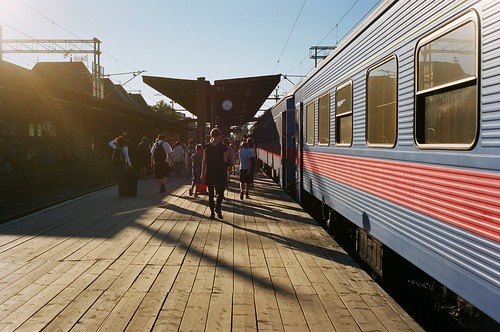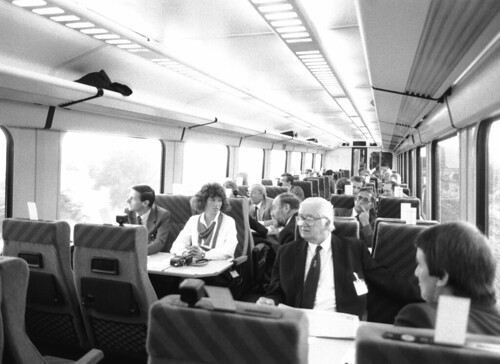
Most people who have travelled on trains in Britain will be familiar with British Rail's Mark 3 stock as these are the carriages in an Inter City 125 train. They have served the railways well and proved a remarkably good investment. The first came into service in 1972 and over 800 were built for service in the UK and a further 120 for the railways of the Irish Republic before production ceased around 1990. In addition, the design was the basis of many types of electric multiple unit trains as well as the International train illustrated in the masthead of this blog, a commercial venture by British Rail Engineering Ltd.
It is well described in the Wikipedia entry but there is more to be said. The 23 metre long bodyshell is a steel monocoque structure, with reinforcing top-hat sections welded on to 3 mm sheet steel. The horizontal members are welded direct to the sheet steel shell and the vertical ones are joggled to fit over the horizontals. There are substantial box section reinforcement members at floor level. The roof is composed of corrugated sheet steel with reinforcing steel diaphragms. Thus the structure is essentially an inverted-U section. This bodyshell construction combines strength with light weight and has not been improved upon.
At the time they were introduced, the mark 3 vehicles were 3 metres longer than anything else running in Britain. The extra length was accommodated by reducing the external width from the maximum permitted, 2.82 metres, to 2.74 metres. There was no loss in space because the reduction was achieved by eliminating or recessing projections such as door handles, though some alterations to the infrastructure were still needed.
Whilst this was an advanced design for 1972, shortcomings became apparent. The need to joggle the vertical top hat sections was time-consuming in the manufacturing process. This might have been avoided if corrugated sheets had been used for the bodyside, as in these Swedish vehicles built around the same time.

The suburban multiple unit versions were prone to corrosion of the floor and lower bodyside, where large amounts of rusty water could collect. This was possibly due to the lack of air conditioning, leading to condensation, as the inter-city vehicles are hardly affected by corrosion apart from the floors in the toilets.
From the passengers' point of view, mark 3 stock suffers from niggling features. The wrap-round doors are heavy, awkward and eventually had to be fitted with secondary locking, following a series of fatalities. Very few of the vehicles were fitted with power operated doors. The window cills are too high, especially for small children who cannot see out of the train. The bay dimension of 2.1 metres, with eight bays per vehicle, is based on the spacing of first class seats and consequently the more closely spaced seats in the standard class vehicles are misaligned to the windows. A "window" seat may or may not have a window alongside. The seat reservation system does not have this information and some passengers end up with no view out of the train. These issues were addressed with the International train, which had power operated doors and a bay dimension of, probably, 1.90 metres, giving an extra seating bay in each vehicle. This is exactly right if the aim is to optimise capacity and comfort, and was adopted for the Alstom's Adelante diesel train.

However, it is possible to fit 64 seats into a mark 3 vehicle, with all being fully aligned to the bays, plus four seats with no view. The International allows 72 aligned seats (above). In recent refurbishments, some mark 3 vehicles have been fitted with fully aligned seats and have been widely praised, whereas in others, notoriously, First Great Western, as many seats as possible have been crammed into standard class and the result is described as grim.
The future of the mark 3 fleet
Replacements for the Mark 3 stock have now been ordered, in the shape of the Hitachi Super Express train, specified by the Department of Transport. This seems set to be one of the worst investments in the history of Britain's railways, but it will be the subject of other blogs.DfT takes the view that Mark 3 stock is showing its age. That is a meaningless statement. Rail vehicles are like houses, with systems and components that wear out and become obsolescent at different rates. A few components may last longer than the vehicles themselves and should be recovered and re-used. Basic good housekeeping should apply. One does not demolish one’s house because it needs repainting. The main structure of a steel monocoque railway vehicle such as a mark 3 can reasonably be expected to last for 60 years, which means they should continue in service for another 20 or 30 years. The use of old stock is an important means by which the burden of fixed capital costs can be kept down. So far as the passenger environment is concerned, there is little or no perceptible difference between an old vehicle and a new one, since it is comfort, space and presentation that are noticed. There are certain issues with the mark 3 fleet but their life expectancy is sufficient to be worth addressing them.
There is also the matter of the fleet now being disposed of from the Irish Railway system. So far as I am aware, little serious study was done regarding the issue of gauge conversion of these vehicles, which are actually newer than the British fleet, have power-operated doors and would have been a useful and relatively inexpensive addition to the railway’s resources. The DfT appears to have missed another trick here.
DfT argues that re-use of mark 3 fleet will not have the capacity for growth, but the exact opposite is the truth: its retention and augmentation with new compatible vehicles, plus, possibly the Irish fleet, would seem to offer the best possible means of increasing capacity.
Future developments
The mark 3 concept has come to an undeserved dead-end. The International configuration with larger and more closely spaced windows was an excellent one, offering passengers a much improved ambience. Corrugated sheet structures are a sound and well established means of adding strength and stiffness without adding to weight. Stainless steels are now more readily available in suitable grades and their use should lead to greater longevity and reduced maintenance costs. A fleet of vehicles designed on these principles, locomotive-hauled and compatible with the existing mark 3 fleet, would provide enhanced capacity and future flexibility. It would probably look something like this. The DfT should be made to review this matter as soon as possible after the election.
Kommentarer